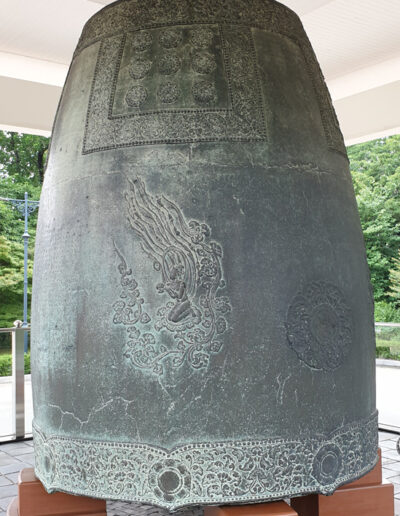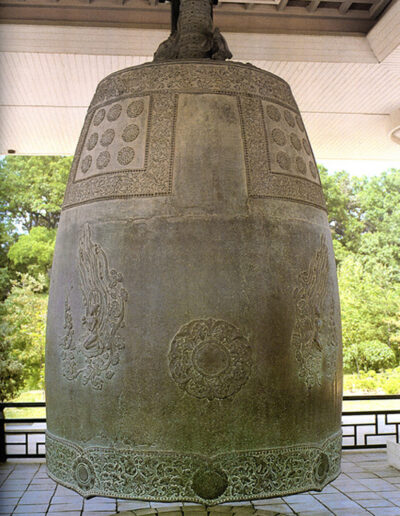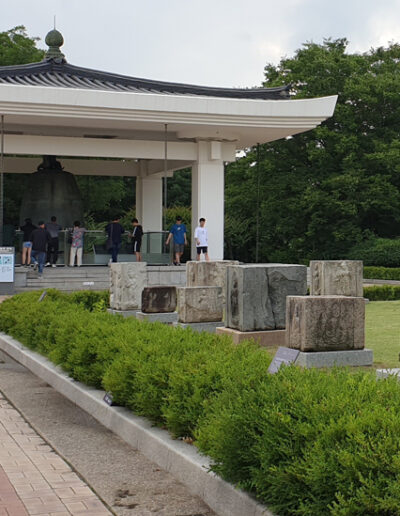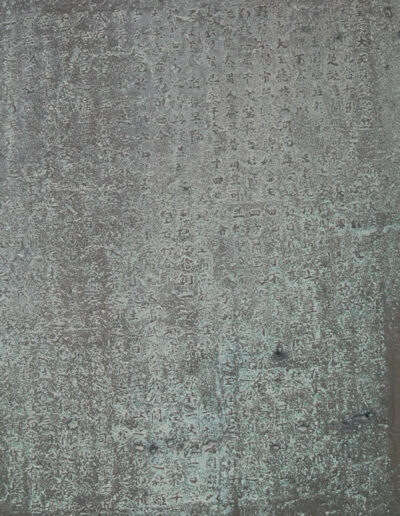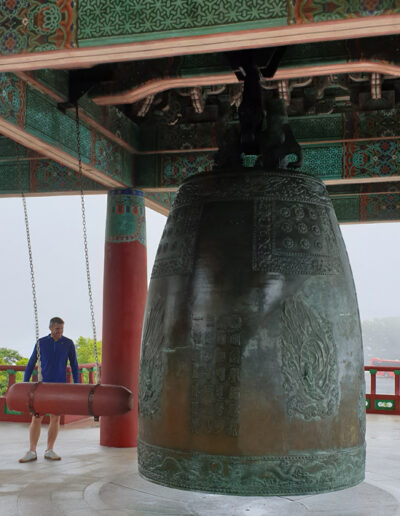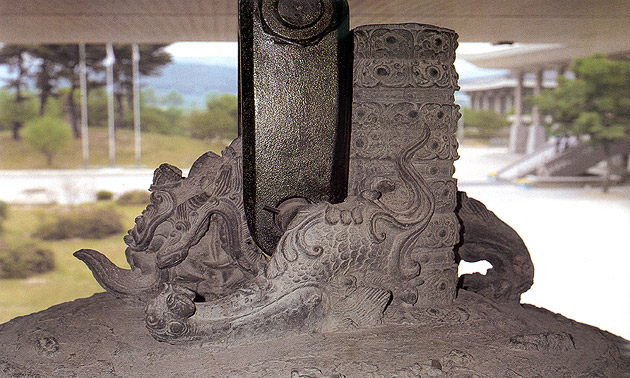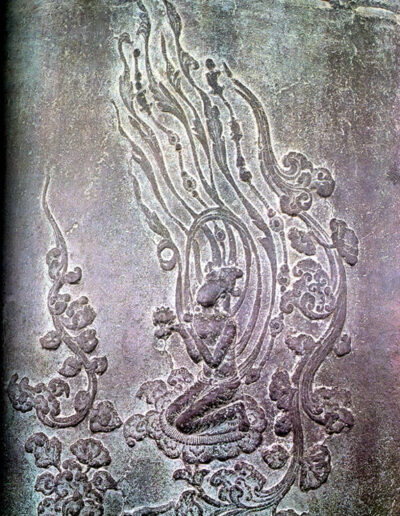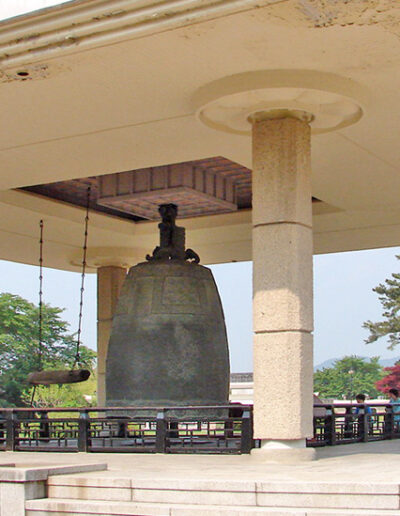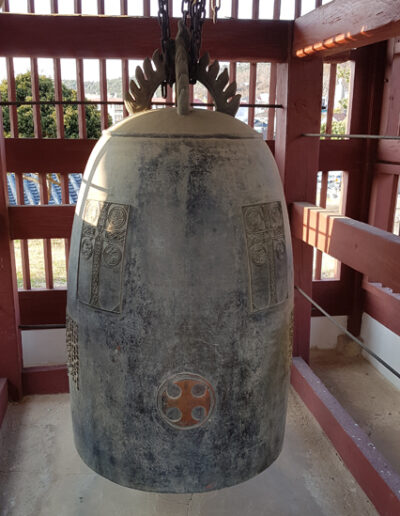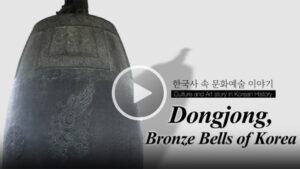The Divine Bell of King Seongdeok
771 CE
About the Object
Story of the Object
Teaching suggestions
Classroom Extras
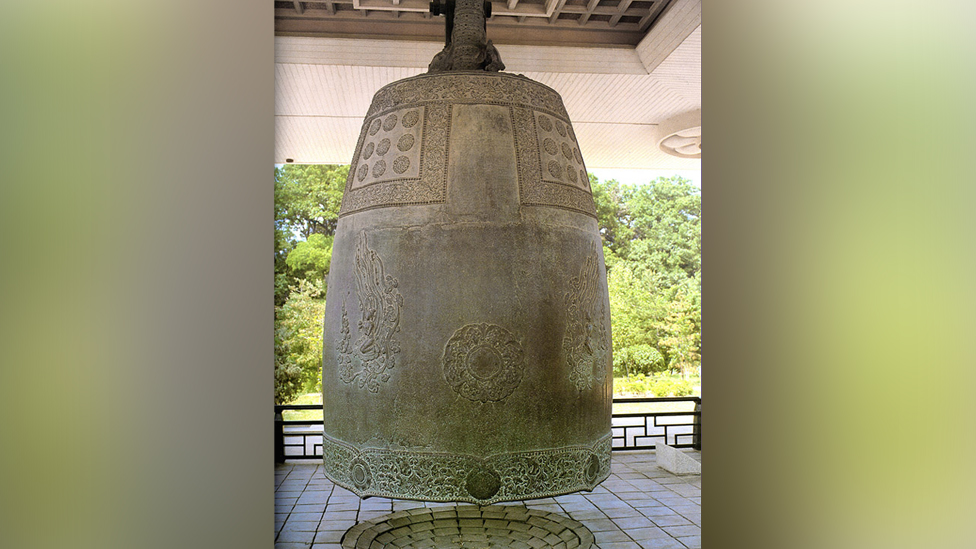
The Divine Bell of King Seongdeok at Gyeongju National Museum © Korea Heritage Service
The Divine Bell of King Seongdeok
The Bell of King Seongdeok is the oldest surviving bell in Korea and was completed in 771.
The bell was to honour the life of King Seongdeok; as a result, it is known as the sacred or divine bell.
It is also called the Bell of Bongdeoksa Temple, because it was hung first at that temple, and the Emille Bell, after a legend about how it was cast.
The bell is one of the National Treasures of Korea and it is now housed in its own special building at the Gyeongju National Museum.
Origins of the Bell
The bell was commissioned by King Gyeongdeok of Silla (reigned 742-765) in memory of his father King Seongdeok (reigned 702-737).
The process of making the bell started in 742, but King Gyeongdeok did not live to see it completed.
The bell was finished six years after he died in December 771, during the reign of King Hyoseong (765-789).
King Gyeongdeok was famed for a number of architectural projects.
Besides the bell and a separate tomb in honour of his father, his reign saw the construction of the Seokguram Grotto and the Bulguksa Temple, both of which are now included in the list of National Treasures of South Korea and the list of UNESCO World Heritage sites.
Description of the Bell
The bell is enormous.
It is 3.75m high and 2.27m in diameter at the bottom, or rim.
The thickness of the bell metal varies from 12 to 25m.
It is made of bronze and when measured in 1997, it weighed 18.9 tons.
In effect, the bell is the same height as one African elephant, measured from the toe to the shoulder, and weighs about the same as two elephants.
At the top of the bell is a hollow tube on top which is designed to determine the tone of the sound when it is tolled.
The hollow tube is a highlight unique to bronze bells made in Korea.
Next to the tube is a hook which is carved in the shape of a dragon’s head and is used to hang the bell.
This feature is a fine example of what is referred to as a “dragon- shaped bell loop”, when a dragon’s head is placed on the surface.
The outside of the bell is embellished with a number of delicate designs.
There are, for example, flower patterns around the rim at the bottom and on the shoulder at the top and they include lotus flowers and grass.
The striking point of the bell, or dangiwa, is in the shape of a lotus and sits between two apsaras, or heavenly maidens who attend Buddha.
The two apsaras are kneeling amongst lotus plants and holding up incense burners and are sculpted in such a way as to suggest they and the plants are looking upwards towards the sky.
The bell is inscribed with text which explains the bell and why it was made.
It consists of about 1,000 Chinese characters.
They bear witness to the elaborate carving style of the period and the text is an excellent example of Korean calligraphy.
When tolled the bell has a long reverberating sound which is claimed by some to be unique.
Together, the size, the precise casting, the elaborate decoration, the low-pitched tone, and the high-quality Korean calligraphy mean that the bell is regarded as one of the most important surviving masterpieces of Silla art and of Korean metalwork.
History of the Bell
After it was made, the bell was sited at Bongdeoksa Temple, a Buddhist temple in the southwest of the Korean peninsula.
The bell has had an interesting history.
It appears to have been buried in the early 15th Century when the temple suffered from heavy floods.
It was rediscovered, taken to Yeongmyo Temple in about 1460 and moved again in 1506 to be sited next to an ancient tumulus in Gyeongju.
From that time, the bell was used to announce the opening and closing of one of the city gates and the enlistment of soldiers.
In 1915 the bell was taken to the Museum of Gyeongju.
During the period of Japanese colonial rule (1910-1945), the bell was nearly melted down to make weapons.
Fortunately, it was spared this fate and in 1975 it was moved to the Gyeongju National Museum where it has been on display in its own pavilion ever since.
Until 1988, the bell was struck every New Year’s Eve.
However, to help preserve it, the bell is rarely rung.
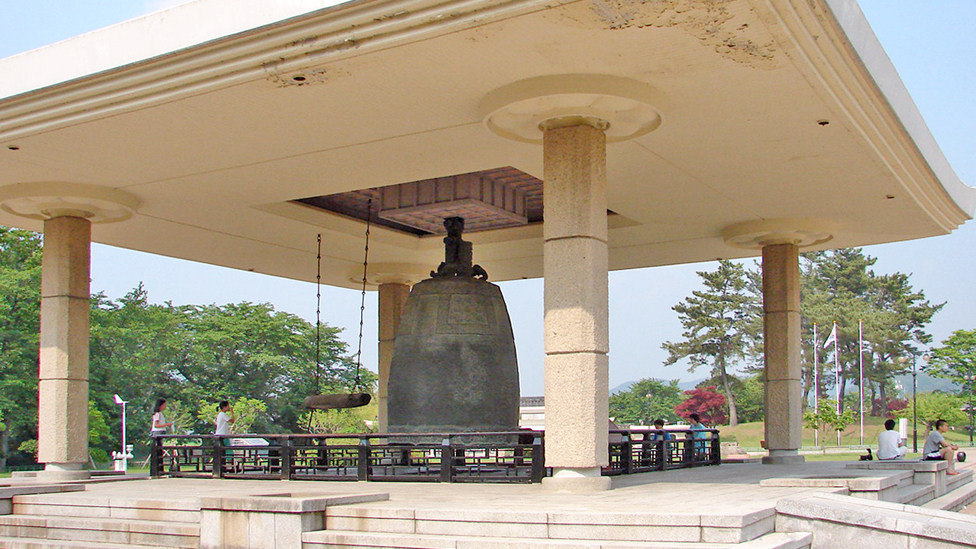
The Divine Bell of King Seongdeok. ©The National Museum of Gyeongju
The Legend of the Bell
The bell is also known as the ‘Emille’ Bell.
The name derives from an ancient legend in which a baby was allegedly sacrificed in order to give sound to the bell.
The sound of the bell tolling was said to resemble the word Emille (pronounced em-ee-leh) which is the traditional Korean word for
‘mummy’.
A frequent telling of the legend alleges that when the first bell was cast it produced no sound.
Further attempts to cast a bell with sound were also unsuccessful.
Sometime later a monk dreamed that if a child was cast into the metal, the bell would ring.
The story goes that the monk took a child from a local village and had her cast into the metal.
When the bell was finished and rung, the sound it made was said by some to be beautiful but by others to be like a child calling for its mother.
However, according to another version of the legend, in the 13th Century, the task of casting the bell was so overwhelming for the man responsible that he was driven to throw his own daughter into the molten bronze in the hope that her sacrifice would allow the bell to be finally made.
In this version of the legend, the sound of the bell when rung is also said to echo the girl’s despairing cry of ‘emille’ (or mother) as she was thrown into the bronze.
As with all legends, the details have changed over time in the telling and retelling.
As a result, we have no idea as to whether the story of the casting of the child has any accuracy at all.
Significance of the Bell
In thinking about significance, we should consider two aspects.
One is about King Seongdeok as a monarch and the other is about the importance of bells.
The reign of King Seongdeok is regarded as the highpoint of the period of the Unified Silla state (668-935).
During his reign relations with the Tang rulers in China improved after a period of much confrontation and competition.
He built defences to protect his kingdom from attack by land and by sea and the fortress he had built near his capital of Gyeongju was said to have had a circumference of 10km and built by nearly 40,000 labourers.
Such a feat suggests a monarch who had extensive centralised authority.
Overall, King Seongdeok’s reign was one of peace and prosperity.
As a result, he was much revered by his successors.
Throughout Korean history, and as in other societies, bells have been used extensively.
In Buddhist temples and monasteries in Korea, large bells were rung to announce services at the beginning and end of each day while smaller bells heralded other services and rang out each hour.
Dedicating a bell to a particular king and siting at a temple indicates clearly that he was someone to be revered and an individual who was never to be forgotten.
This is because every time the bell rung people would hear and remember him and the achievements of his reign.
At the entrance to the Seokguram Grotto and Bulguksa Temple Complex at Gyeongju there is a replica of the Divine Bell. For a fee, it is possible to ring the bell.
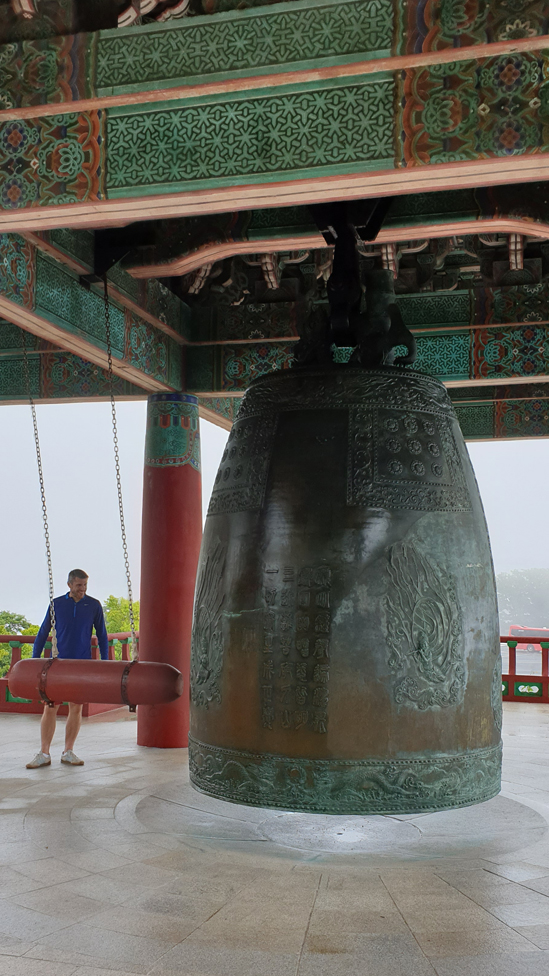
The replica Divine Bell at the entrance to Seokguram Grotto and Bulguksa Temple Complex Gyeongju
Retrieval practice
Where else in the World?
Ask pupils to research important who people lived at this time, or what other important events or developments took place?
This could have a Korean focus, or, it could be expanded to give a global perspective. You might want to widen the period of study to the whole of the 8th Century.
For example, in Britain, the first recorded Viking raid took place in the late 8th Century. This was the start of a fierce struggle between the Anglo-Saxons and the Vikings in Britain.
Also, around this time, Baghdad was chosen as the capital of the Abbasid Caliphate. It soon became the largest city in the world, with a population of about one million.
Writing a plaque
Ask your pupils to write a plaque for the bell. They will need to research this famous bell. They could work individually, in pairs or in groups. You could support them by giving them to following headings to find out about:
- Who commissioned the bell? Why?
- How was the bell made?
- What is its significance in Korean history?
After they have completed their research explain to them that they need to write a plaque for the bell.
Give them a word limit of 40 to 50 words.
This makes the task much more challenging as they will have to choose their words carefully.
Act as a TV researcher
The bell was commissioned to honour the life of King Seongdeok. This is a great opportunity to get your pupils working with the concept of historical significance.
You could put them in the role of a TV researcher working on a documentary about King Seongdeok.
You might explain to your class that the producer thinks the programme should give equal time to the following:
- Relations between Silla and the Tang dynasty (15 mins)
- The construction of the Vodka aqueducts (15 mins)
- Reforming the Land system (15 mins)
- The creation of the first water clock (15 mins)
Your pupils need to find out about each of the above topics and consider how significant the topic is in helping us to remember King Seongdeok.
They should then suggest new amounts of time for each event.
Bells
Begin with a simple explanation of what bells are and the functions they serve. You might want to allow students to ‘brainstorm’ their ideas.
Ask pupils to research well-known bells. Perhaps set a target of 3, or 5, or 10. This could be an individual or group project.
Create fact files for each crown:
- When was it created?
- What materials were used?
- Why was the bell created?
- Is the bell still used? If so, where is it? If not, what happened to it?
- Add pictures.
There are many, many examples, from all over the world.
Get pupils to identify similarities and differences.
Examples that are easier to find information on include: Big Ben – the nickname for the Great Bell of the Great Clock of Westminster, at the north end of the Palace of Westminster in London, England; The Liberty Bell, previously called the State House Bell or Old State House Bell, located in Philadelphia; The Tsar Bell, or Royal Bell, on display on the grounds of the Moscow Kremlin.
How was the Bell made?
Classroom Extras
Here you will find a number of images, video clips and website links which can be used as extras for teaching in the classroom or for use by pupils undertaking independent research.
Images
Study these photographs of the Bell:
Map
Discover more online
Korea Heritage Service: Sacred Bell of King Seongdeok
Korea Herald: Divine bell Emile Jong resonates in the hearts and souls of Koreans for 1,250 years

